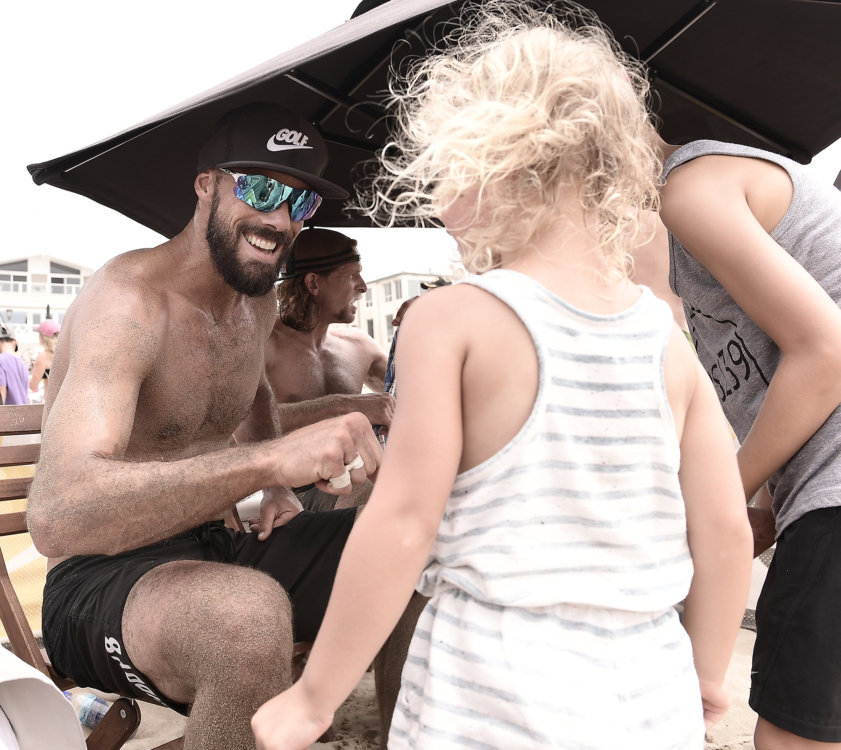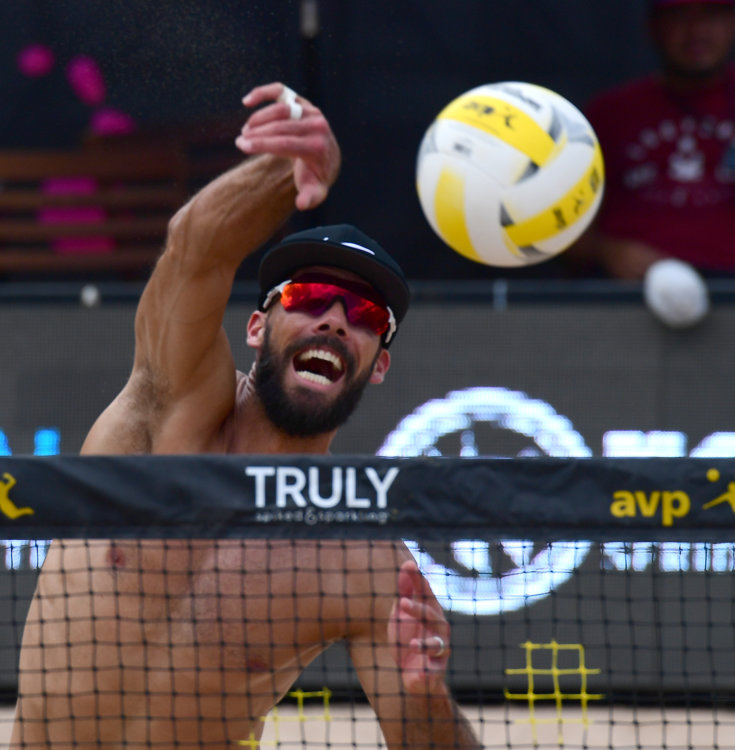Reid Priddy is one of the greatest volleyball players. Ever.
I don’t say that lightly. There are hundreds of talented athletes that have played our game, both indoor and on the beach. But on the men’s side, few have successfully transitioned from professional indoor volleyball to the AVP and beyond—especially with an indoor career as stellar as Reid’s.
Just a quick recap—Reid played 16 years for the USA National Team as an Outside Hitter. In my opinion, Outside Hitter is the hardest position to secure. You’re both often the highest scoring player on the court and have to play all the way around. For Reid to have kept it for 16 years is a feat in itself, not to mention the success he had in that role.
Reid played in six different countries professionally over 15 years and was typically one of the best players in the world. He has two Olympic medals with the USA—Gold and Bronze—and has competed in the Games four times. FOUR TIMES. After Reid got the Bronze at Rio 2016, he retired from indoor and came to the beach. He was 39-years-old. No big deal. In his first two seasons, he made six semifinals and won the coveted MBO in 2019.
I first met Reid during Spring 2018 in Mexico. Two men’s and two women’s teams competed in three tournaments in as many weekends, so our little travel envoy grew close quickly. Reid was lovingly deemed “Dad,” both because he was the only athlete older than 26 and also because he actually has two kids. He has a lovely “dad vibe.” He’s patient and kind and listens well, has great conversation topics and challenges you to think deeply. He also has a calming energy and shared his bags of organic chocolate. We needed dad energy to keep us in check, and Reid fit the bill.

One of my favorite memories of those three weeks is a dinner with Reid, his partner Troy Field, and my partner Kenzie Ponnet. Our trip was almost over, and after three cities, multiple bouts of Montezuma’s revenge, and so many card games, our guards were down and we trusted one another. We started talking about volleyball, as we do in most conversations, but it soon led to life and love. We were vulnerable and compassionate; everyone listened and learned, taking turns being open and being quiet.
Most of the rich content from that dinner came from Reid. He made me want to approach the game the way he did—cerebrally yet spiritually. Volleyball has been Reid’s life for more than twenty years now, so it shouldn’t have surprised me that he’d gleaned so much meaning from the game. Reid revealed countless ways volleyball can be applied to different aspects of life – career, faith, relationships, self-growth, and more.
So, for my sake and all of yours, I had to reach out and get some more Reid wisdom.
How did you form your approach to beach volleyball after your stellar indoor career?
It started with the writing of my first book—Max Potential Playbook. I didn’t intend to write one, but through a series of events, I found myself responsible for 15 hours of teaching over a four day period of time. I took that opportunity very seriously so I sat in my office and began to think, “What should I say to these athletes and coaches? What do I think is most important?” I began to write and it became sort of a stream of consciousness flow. I had just finished 16 years of indoor so as I looked back I saw very distinct patterns and a clear process emerged. This process was a direct sequence that led to reaching my max potential. With that clarity in mind, I was able to start from the first step on the beach and work through the process.
The process starts with the requirement to establish the right mindset about the process in general. I saw two major inputs here, the need to be all in, meaning you have to take personal ownership, be willing to leverage your whole self into whatever endeavor you’re going for.
The second is having a growth mindset, or process-driven mindset, rather than a fixed mindset or results-driven mindset. Establishing the right framework, or how you think about the process, is a really really important first step.
After that, it’s also really helpful and empowering to know yourself a little deeper. Discover your driving force. What is your Why? What are the gut-level drivers that led to the decision you make? Once I was able to articulate my Why, it helped me to understand why I say yes to certain things and what I must say no to others. It is a guide to help you stay focused and on the right path. Then, with your driving force in mind, you clearly define the mission, and you must write it out on paper.

How did accruing information about who you are as a person help you accomplish your goals on the beach?
When transitioning to beach volleyball, I started to think with the end in mind. Before I even started, I began to think through, Ok, why am I doing this? What do I want to get out of this experience? What is the ultimate goal? And for me, the ultimate goal was to see if I had what it took to make an Olympic Run on a different surface. That’s what set up my personal mission as I transitioned to the beach.
Once that mission was declared, I went through a process where I built out an avatar. I try to figure out the answer to: What person, what characteristics or skills does a person who accomplishes that mission have? How do they act? How do they perform?
Then I look back and compare it to where I am today. That contrast reveals a distinct gap between the end goal and where you’re at now—and begins to inform me on how to best spend my time and make real progress towards my ultimate goal. It sets up the basis for which all training runs. What are the main components that will help me reach my goal? If there are 15 different skills that go into beach volleyball, what are the 3-5 skills that really move the needle in terms of points won or lost?
Then I map out a plan. What is it going to take to acquire the skills, behaviors and patterns that a player that accomplishes my articulated goal has? In this phase, it’s important to not think about what’s possible. You ask yourself what’s necessary. What has to happen from a scheduling standpoint. If I really want to do this thing, what do I have to do on a regular basis? Then I build out the calendar with that in mind. In that step, I count the costs. Do I have the bandwidth or the energy to make this particular journey? That’s when I make the commitment.
So all of that work happens prior to the hard commitment. Because I want to be honest with myself. If I look at what’s necessary and it’s too much, it’s only fair to myself, my family and my team that I be honest about that.
Okay, so your commitment is made and you’re sure you have the bandwidth to put yourself in Olympic contention. So how does all of this prep work influence your practices?
“Every rep counts” is a mantra that I had ingrained in me from some amazing coaches. So I try to ensure that every rep is fully embraced and in that mindset, I train to win. There is no rep that you take off and try to be as efficient as possible. There are lots of feedback loops that have to happen in this phase. Watching video, doing an action and then evaluating that action. It’s not to feel great about the result, but trying to understand, “Am I growing and developing? Where am I in the developmental phase?”
The end goal for me is about mastery—control over self, control over the ball. That’s what I’m pursuing. It’s more of a martial arts concept, and I think about fighters that have earned a black belt. A boxer is evaluated by his record; a black belt in any MMA or Karate or whatever discipline is evaluated by his proficiency over time. That’s how I view sports in general. I’m trying to become as proficient as possible in this particular domain. For beach volleyball, it’s a lot about ball control on an unstable surface, in unpredictable environments with constantly shifting conditions. There are so many things you can’t predict.
Now that you have a few years of professional beach volleyball under your belt, what do you feel is the biggest difference between the two sports?
In indoor, not only is our training more structured, but the game itself is more structured. There’s just more predictability, it would seem. It seems like mastery of beach is having all the tools necessary to handle the unpredictability that happens even amidst the one play. There’s so much unpredictability. The minute you say to yourself, I’ve got this figured out, something shifts—the wind shifts, your opponent changes something. There is no one right way.
In my preparation, I work on being proficient in the skills, understanding the strategy, and trying to be ready and willing to adapt to the ever-changing circumstances that present – from opponents to locations to environment to atmosphere.
What is your favorite strategy/intellectual element of indoor? Same question for beach.
For indoor—I like the power aspect of the game and I like the team dynamic. But it really comes down to a game of numbers; it’s probability. You reach the mastery of the skills, and then it becomes a chess game of probability where you can get small fractional percentage points of advantage against your opponent by recognizing patterns and knowing the numbers. That chess match is a fun, engaging process. I like that about indoor.
For beach, it’s almost like the reverse. You have to be prepared for everything in real-time, to be able to problem-solve. I would think that most every athlete loves this aspect about beach volleyball. There almost seems to be no two plays that are alike. It’s so unpredictable and I think you just want to be in the fight, trying to pick the lock on your opponents, on how to score points and stop the other team from scoring. There’s never one right answer and it’s never the same.
Is there a strategy or philosophy that applies to both sports?
My philosophy is—”Skill takes the risk out of aggressive play.” It bodes true on both surfaces. The goal is to play as aggressively as possible, but without incurring risk that shoots ourselves in the foot. The way to reduce risk when you want to play and operate aggressively is to become more skilled. The philosophy sets me up to have the mentality to put in every hour of work that I need to level up and master the skills. The reason I do that is so I can play more aggressively, especially under pressure and when it counts.
What’s amazing about this process is that it didn’t just help me compete in indoor or transition to the beach, but over the last three years I have had the privilege of sharing this process in almost every major industry across the country and have watched people find results in their “game”. Be it junior athletes, finance specialists, sales reps, leaders of teams or even steel manufacturers…we all have capacity for more, and it’s always helpful to have a process to follow that is geared towards maximizing growth.
——
If you are interested in learning more about Reid’s Max Potential Process, visit his website at www.reidpriddy.com
Follow Kim Smith on Instagram @kimesmith21
Read more from Kim: